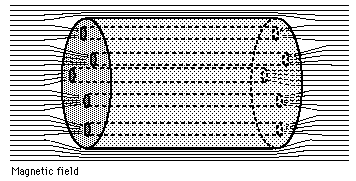1400 MHz Peak Flux Density Measurements for all Faint Radio Burst Detections by two Telescopes:
6 faint radio bursts all at or near 1400 MHz at Parkes radio telescope
Recent FRB 121102 burst also at 1400 MHz
1.4 GHz = 1400 MHz for the flux density of FRB 121102.
The famous Lorimer bursts in 2007 were also at 1.4 GHz and known to resemble faint radio bursts.
Explaination for Faint Radio Bursts Puzzling Astronomers:
(1) IBEX detected neutral helium near earth's orbit, and the highest amounts of neon in the interstellar wind. IBEX also detected a secondary population of neutral helium near our sun's outer heliosphere, and abundant helium in the intergalactic medium. The motions of interstellar gas produces electric currents says NASA. Helium atoms become excited by electric currents, and collide with neon atoms inside flux tubes, to produce lasers and faint radio bursts. Flux tubes are in the resonant cavities of magnetized plasma bubbles, and scale to cosmic sizes that form Birkeland currents that carry electric currents in filaments.
Helium comprises 6.5% of all the atoms in the universe, and neon comprises 0.01%. Neon is the sixth most abundant atom in the universe. There are only 3 times more carbon atoms, and six times more oxygen atoms, than neon atoms. This exemplifies that the helium-neon laser is a simple, efficient, and common laser in outer space filaments.
(2) Plasma flux tubes scales plasma to the largest known sizes of cosmic structures. Solar wind flux tubes form planetary magnetospheres. Excited neon gas becomes metastable in cosmic flux tubes during collisions with excited helium gas, producing laser filaments with flux matching that of the faint radio bursts or FRB's.
Magnetosphere solar wind flux tubes
1400 MHz Doppler Flux (FWHM) by Helium-Neon 632.8 nm red lasers were designed to produce the strongest natural and most efficient output.
Faint radio bursts are pulse waveforms
1.4 GHz = 1400 MHz
Electric current flows through the gasses
Terrestrial Gamma Ray flashes produce weaker radio bursts occurring up to several thousandths of a second before or after the TGF. A TGF actually represents the individual lightning bolt associated with it.
Famous neon nova 2012
The emerging Birkeland Current cosmology of plasmas, superfluids, and supersolids. Birkeland current electrical filaments and jets inside interacting symmetrical and asymmetrical vacuum flux tubes with associated magnetic fields, magnetic ropes, and magnetized plasma bubbles:
Galaxy Flux Tubes:
Flux tube radio galaxy 3C353 is wrongly believed to have a black hole at the empty center.
Flux tube radio lobes in galaxy
Galaxy Cluster Flux Tubes
Supernova Flux Tubes:
The crab nebula flux tube
Flux Tube Nebula or Ring Nebula M57 - by Electric Universe Thunderbolts - Steve Smith at EU Thunderbolts writes "A neon lamp that emits light only at the excitation frequency of a specific gas is a correct nebula model."
Jupiter's moon Io is connected by a lightning bolt of electricity inside a huge rotating flux tube
Molecular Clouds and Nebula Flux Tubes
Flux tube molecular cloud
Orion molecular cloud complex
Protostellar Flux Tubes
Protostars streaming inside an evaporating gaseous globule and hydrogen filament that connects to a flux tube where two opposite jets are pinched to form a new star.Emissions and Fluorescence of Excited Atoms:
Magnetic Flux Tube Ropes, Kinks and Knots:
Magnetic flux tube ropes
Flux Tubes in Spiral Arm Filaments of Galaxies:
Animation of massive star formation on a bubble cavity with magnetic flux.
Let's take a closer look near the recent faint radio burst 121102:
Electrical filaments shown near the detection location of FRB 121102 likely extend into the region.
FRB 121102 was detected at a location very slightly beyond the upper left region of this photo of the nearby emission nebula IC 410.
Magellanic stream of ionized hydrogen plasma gas.
All four FRB's (marked as red asterisks) can be seen to be located at or near possible intersections of vast galactic filaments produced by supernovas connecting to the milky way galaxy, and are not random sky emissions as believed:
Helium-Neon Holograms
This cosmology produces all kinds of holograms, including ultraviolet holograms.
Sources and references:
NASA states that interstellar gas motions generates electric currents. These electric currents excite abundant helium gas, that excites neon atoms in cosmic flux tubes, to produce lasers with the 1400 MHz flux that matches all faint radio burst flux.


























































































No comments:
Post a Comment